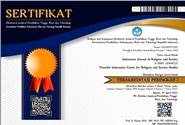The Characterization of Hua Mulan in Disney’s 2020 Live-Action Mulan
Abstract
Disney's 2020 live-action film Mulan is remade of the 1998’s cartoon version, with several changes, including the characterization of the main character. This study aims to investigate the characterization of Hua Mulan as the main female character in Disney's 2020 Live-Action Mulan. Using the qualitative interpretive method by Miles, Huberman, & Saldana (2014), the research was conducted in four simultaneous processes: data collection and condensation, data display, and conclusion drawing/verification. This research revealed that Mulan is a village girl who was reckless, brave, strong, and often acted like a boy. When Mulan grew up, she became a brave and tough person who made she could protect herself and her family. Moreover, it reflects Mulan's independence which is represented by her ability to survive and fight alone for the sake of her family and empire. Furthermore, Mulan also had an extraordinary "Chi" power that made her a strong warrior. Her family and society also respected Mulan for her honesty in revealing her mistakes. The depiction of Mulan, who has a masculine character, implies that Disney's 2020 live-action Mulan can be used as a role model by the audience in protecting and loving those around them.
Keywords
Full Text:
PDFReferences
Adyatmasani, I. A. W. (2021). The representation of liberal feminism in the character of Hua Mulan in Mulan Movie. Universitas Sanata Dharma.
Aquino, J. (1976). Science Fiction as Literature. Washington D.C: National Education Association, 22(3), 563–563.
Ayu, D. M. I. (2017). An Analysis of The Motivation Reflected By The Main Characters In The Movie “42” And Its Personality Influence. Deiksis, 9(01), 13. https://doi.org/10.30998/deiksis.v9i01.1123
Blangsinga, G. W. K. A. A., Suwastini, N. K. A., Lasmawan, I. W., Adnyani, N. L. P. S., & Rusnalasari, Z. D. (2021). Patriarchal binary oppositions in narrative texts included in English textbook for senior high school in Indonesia. 2nd International Conference on Technology and Educational Science (ICTES 2020), 135–141. https://doi.org/https://dx.doi.org/10.2991/assehr.k.210407.227
Bordwell, D., Thompson, K., & Smith, J. (2017). Film Art: Creativity, Technology, and Business. In Film Art: An Introduction (11th ed.). McGraw Hill.
Chen, R., Chen, Z., & Yang, Y. (2021). The creation and operation strategy of disney’s mulan: Cultural appropriation and cultural discount. Sustainability (Switzerland), 13(5), 1–19. https://doi.org/10.3390/su13052751
Eder, J. (2010). Understanding Characters. Projections, 4(1), 16–40. https://doi.org/10.3167/proj.2010.040103
Fasikh, M., & Indriana, Y. (2022). Analysis of Olivia Pullman’S Character in “Wonder” Movie. Journal of English Language and Literature (JELL), 7(1), 35–46. https://doi.org/10.37110/jell.v7i1.141
Gill, R. (1995). 189 - Mastering English Lliterature.
Harinanda, S. A., & Junaidi, A. (2021). Representasi Feminisme Pada Film Disney Live-Action Mulan. Koneksi, 5(2), 269. https://doi.org/10.24912/kn.v5i2.10299
Istighfarah, F. (2021). Building students character through moral values in “Mulan” Movie (Issue April). Universitas Islam Negeri Ponorogo.
Khairunnisa, A. (2018). A Comparative Analysis of the Representation of Disney’s White and Non-White Women in Brave (2012) and Moana (2016). Passage, 6(1), 19–39.
Kinsella, E., Ritchie, T., & Igou, E. (2017). On the Bravery and Courage of Heroes: Considering Gender. Heroism Science: An Interdisciplinary Journal, 2(1), 1–14. https://doi.org/10.26736/hs.2017.01.04
Miles, M. B., Huberman, A. M., & Saldana, J. (2014). Qualitative data analysis: A methods sourcebook (H. Salmon, K. Perry, K. Koscielak, & L. Barret (eds.); 3rd ed.). SAGE Publications.
Putri, A. E. E., & Retnaningdyah, P. (2021). Women’s Role in Overcoming Nature Exploitation in Disney Movie Frozen II. Humanitatis : Journal of Language and Literature, 7(2), 129–142. https://doi.org/10.30812/humanitatis.v7i2.1255
Putri, C. (2017). the Characterization of the Main Character in Gone Girl Film. Linguistica, 7(3). https://doi.org/10.24114/ling.v7i3.11888
Putri, T. A. (2021). Viewing Female Depiction in Frozen 2. Language Circle: Journal of Language and Literature, 15(2), 265–274. https://doi.org/10.15294/lc.v15i2.26416
Putriwana, N. A., & Yustisia, K. K. (2021). Belle’s characterization as the main character in Beauty and The Beast movie by Bill Condon. EnJourMe (English Journal of Merdeka) : Culture, Language, and Teaching of English, 6(1), 70–76. https://doi.org/10.26905/enjourme.v6i1.6131
Qingli, X., & Ying, S. (2020). Female Gender Identity in the Adaptation of Disney Live-action Film Mulan. English Language, Literature & Culture, 5(3), 112. https://doi.org/10.11648/j.ellc.20200503.16
Saraswati, I. G. A. D. G., Suwastini, N. K. A., Utami, I. A. M. I., Jayantini, I. G. A. S. R., & Budiarta, I. W. (2021). The Representation of Character Education in the Characterizations of Lily Owens in Sue Monk Kidd’s The Secret Life of Bees. Proceedings of the 4th International Conference on Innovative Research Across Disciplines (ICIRAD 2021), 613(Icirad), 292–302. https://doi.org/10.2991/assehr.k.211222.047
Sulistia, R. (2016). Female Masculinity of Fa Mulan and Its Impact Towards Her Relationship With Male Characters in Disney Movie Mulan. Litera~Kultura, 4(3), 12–19.
Suud, F. M., Sutrisno, & Abd.Madjid. (2020). Honesty: A Multidimensional Study as Motivation for National Character Building. Hayula: Indonesian Journal of Multidisciplinary Islamic Studies, 4(1), 99–116. https://doi.org/10.21009/004.01.06
Suwastini, N. K. A., Asri, N. W. D. P., Wahyuni, L. G. E., & Prastika, K. A. D. (2020). The characterisations of Piscine Molitor Patel in Yan Martell’s the Life of Pi. International Journal of Language and Literature, 4(2), 56. https://doi.org/10.23887/ijll.v4i2.30289
Suwastini, N. K. A., Banjar, I. D. A. O. V. J., Tienty, L. P. C. A., Sasmita, I. M. D. G., & Nitiasih, P. K. (2020). Rachel Chu as liberal feminist in Kevin Kwan’s Crazy Rich Asians (2013). International Journal of Language and Literature, 4(3), 123–132.
Suwastini, N. K. A., Utami, I. G. A. L. P., & Artini, N. N. (2020). Dory’s paradoxical characterizations in Disney’s animated feature film Finding Dory (2016). NOBEL: Journal of Literature and Language Teaching, 11(1), 27–37. https://doi.org/10.15642/nobel.2020.11.1.27-37
Syafinah, I., & Susilowati, E. (2021). The comparison between the Movie of Mulan 1998 and its gemake, Mulan 2020 (Comparative literature studies). UNCLLE (Undergraduate Conference on Language, Literature, and Culture), 1(01), 26–31.
Usman, S. A., Umar, M. S., Tamola, M. S., & Ishak, R. (2021). An Analysis of Gender Equality of Chinese Culture in Mulan Film (2020). NOTION: Journal of Linguistics, Literature, and Culture, 3(2), 75–80. https://doi.org/10.12928/notion.v3i2.4886
Wang, L., Han, B., & Xu, G. (2020). Cultural differences in Mulan between Chinese version and Disney version. Theory and Practice in Language Studies, 10(10), 1332–1336. https://doi.org/10.17507/tpls.1010.22
Wang, Z. (2021). From Mulan (1998) to Mulan (2020): Disney Conventions, Cross-Cultural Feminist Intervention, and a Compromised Progress. Arts, 11(1), 5. https://doi.org/10.3390/arts11010005
White, A. R. (1961). Carelessness, Indifference and Recklessness. The Modern Law Review, 24(5), 592–595. https://doi.org/10.1111/j.1468-2230.1961.tb02189.x
Yasamahadewi, P., Agustina, L. W., Suwastini, N. K. A., Umbas, R., Susanthi, I. G. A. A. D., & Asril, N. M. (2021). Why Should Students Like to Have Severus Snape as a Teacher? Proceedings of the 4th International Conference on Innovative Research Across Disciplines (ICIRAD 2021), 613, 303–310. https://doi.org/10.2991/assehr.k.211222.048
DOI: https://doi.org/10.36256/ijrs.v4i1.244
Refbacks
- There are currently no refbacks.
Copyright (c) 2022 Indonesian Journal of Religion and Society

This work is licensed under a Creative Commons Attribution-NonCommercial 4.0 International License.
Indonesian Journal of Religion and Society (IJRS) Is Indexed By:

Indonesian Journal of Religion and Society (IJRS) is distribute under Creative Commons Attribution-NonCommercial 4.0 International License.













